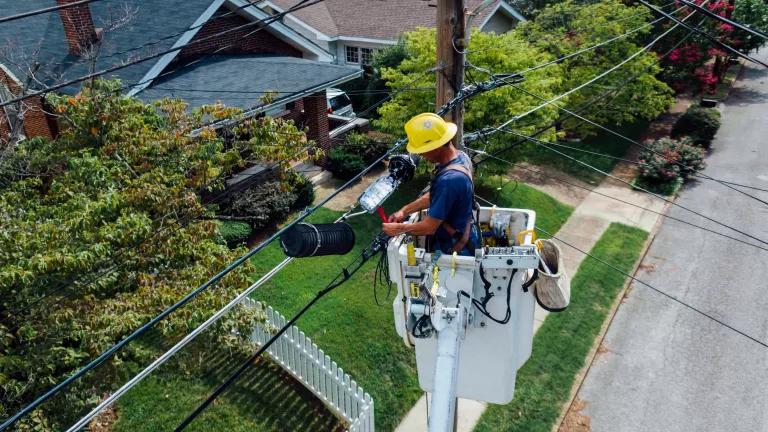Part of NRDC's Year-End Series Reviewing 2015 Energy Developments
For the first time in eight years both the House and Senate energy committees sought this year to advance bipartisan comprehensive energy legislation to address our nation's rapidly changing energy systems and aging transmission, storage, and other infrastructure. But in the end, partisan wrangling put a millstone around the neck of the House bill, while the Senate bill appears to have stalled. Facing hurdles in the normal process, Congress instead inserted major energy policy changes into the must-pass spending package last week.
Over the course of 2015 we saw meaningful proposals on everything from a long-term national energy-savings target to be met through energy efficiency programs and investments in grid modernization to damaging proposals that would allow pipelines to cut through our national parks as well as efforts to turn over a vast swath of the nation's publically owned ocean waters in the Atlantic and Arctic to drilling.
Alongside the hearings and energy bills introduced throughout the year, Congress haggled over harmful funding cuts and policy riders for important energy efficiency and renewable energy programs like those that help Americans save money and energy through minimum efficiency standards. Separately, members of Congress introduced packages renewing a set of expired or expiring clean energy tax credits that have helped speed the deployment of wind and solar power and level the playing field for clean energy--culminating in a sweeping "must-pass" spending package that included extending essential incentives for wind and solar power long enough to provide some real certainty for those industries and protecting funding levels for government programs for clean energy and energy efficiency.
This deal did come with a price--lifting the ban on exporting U.S. crude oil, a top priority for Republican leaders is yet another government giveaway promoting fossil production, inconsistent with the urgent need to address climate change.
Here's a greatest hits list of the energy policies we saw advance this year, including the good, the bad and the ugly:
A Bold Vision for a Clean Energy Future
Senate Democrats provided the boldest vision for energy policy this year, centering on the tools needed to boost our economy, create good-paying clean energy jobs, save Americans money on their electric bills, and curb the dangerous carbon pollution that drives climate change. One of the most promising provisions included in the package unveiled by Senator Maria Cantwell (D-WA) and allies was establishing a national carbon reduction goal of 2 percent annually through 2025, clearly recognizing our obligation to protect future generations from the ravages of climate change. Also included were clean energy tax incentives that promote investments in clean energy production relative to its contribution to reducing pollution.
Taken together, the bill's impact on our families, economy, and climate would be measurably positive. Americans would save $40 billion in energy costs over the next 15 years. We'd see creation or support of 3.5 million jobs. And climate pollution could drop by 34 percent by 2025. It represents the important complementary policies and tools utilities and states need to meet the Environmental Protection Agency's landmark Clean Power Plan to limit power plant emissions and would put our country on the right trajectory to invest in clean and energy-efficient technologies.
Status: Whole bill unlikely be considered by Republican-controlled Senate, but pieces could advance separately.
More than a Missed Opportunity
While each of the energy committees seemed to start this year with a goal of collaboration and an eagerness to develop comprehensive energy legislation in both the House and Senate, things quickly shifted and it wasn't long before bipartisanship was squarely in the rearview mirror with only a grab-bag of polluter priorities leading the way.
After months of hearings and negotiations beginning in April, the Senate Energy and Natural Resources Committee passed the Energy Policy Modernization Act of 2015 which does include some forward-thinking provisions along with a handful that need to be fixed. The forward-looking provisions included permanent extension of the Land and Water Conservation Fund that helps to create and maintain our national parks, refuges and forests; new programs to support grid storage and advanced electric transmission grid technologies; and long-supported policies to promote energy efficiency. However, Senator Lisa Murkowski (R-AK) signaled her priority by simultaneously introducing a separate bill that would open up offshore drilling in the Artic and off the Atlantic coast -- turning publically owned resources over to the oil industry at the risk of our coastal economies, communities, and climate.
Status: Full Senate hasn't considered either bill, unclear if either will get floor time.
Similarly, in the House Energy and Commerce Committee, bipartisan negotiations faltered after Republicans decided to craft a bill based solely on their desire to help the fossil fuel industry. In this bill, even America's energy efficiency policies, which have long had bipartisan support, fall far short of the opportunity available to catalyze investments in this cheap, clean energy resource. In fact, the North American Energy Security and Infrastructure Act of 2015 (H.R. 8) passed by the House this month represents the first piece of legislation in recent history with an energy efficiency section that has the potential to increase energy consumption and cost Americans billions--all while propping up outdated policies and an increasingly uncompetitive fossil fuel industry as well as broadly rolling back laws and processes that protect the environment and public health.
Status: House Passed and sent to Senate for consideration.
And the single missing piece from both of these "comprehensive" energy packages--any attempt to address the impacts of climate change, ignoring the values shared by millions of Americans.
Ugliest Attempt to Undermine Clean Energy Policy
Even though polls show Americans support energy efficiency measures, some members of Congress seem intent upon torpedoing energy-saving standards. The worst proposal of 2015 would have repealed all state and federal efficiency standards for appliances and equipment, even as these standards helped Americans consumers save $60 billion on their utility bills in 2014, alone, and resulted in the U.S. avoiding emissions of 2.3 billion tons of carbon dioxide, equivalent to the annual carbon emissions from nearly 500 million automobiles.
Consumers can't tell from looking at the outside of a building or an appliance whether it will unnecessarily gobble energy and few energy efficiency policies are as impactful or far-reaching as robust building energy codes and appliance standards to prevent that. Without standards, cost-effective energy efficiency opportunities would be lost, leading to unnecessarily high energy bills, increased energy consumption, as well as allow inefficient products made abroad for foreign markets to flood the U.S. market, undermining American manufacturers and destroying U.S. jobs.
Equally as troubling were the more targeted attempts by House Republicans to block progress on DOE's energy efficiency standards for furnaces, ceiling fans, and light bulbs. Thanks in large part to the leadership of House and Senate Democrats and the White House, the Office of Energy Efficiency and Renewable Energy at DOE saw a slight bump in funding for FY2016 and efficiency standards were protected for all products except light bulbs.
Looking forward to 2016
There was a lot of activity and debate on energy policy in 2015, but not around the priorities Americans value: protecting their air, water, communities and natural heritage. We need clean energy policy that responds to today's needs and rises to tomorrow's challenges. American innovation is delivering new technology and opportunities to enhance the nation's security and create jobs while reducing pollution. The energy decisions we make today will shape future generations' economic and environmental future. Here's hoping 2016 is brighter when it comes to clean energy policy in Congress.



